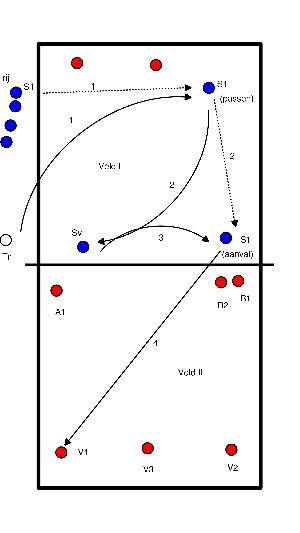Volleyball drills for technique block / net defense
- 2 rows behind the back line.
- First 2 stand in the field.
- Trainer brings in ball.
- Pass left player towards position 2/3 then setup of right player.
- The passer goes to attack on own side of the court.
- The setupper does attack coverage.
- The two teams rotate to form a new pair.
- Extension: There are now 2 attackers at the net.
- The rest do exactly the same as before.
- Attackers come back from the net after the coach has brought in the ball.
- The setup always goes to the opposite corner from the set-upper.
- Pass from the right back, then left back setup on the right front.
- Set-upper covers and takes the place of the attacker.
- The passer remains standing and so does the non-offending player.
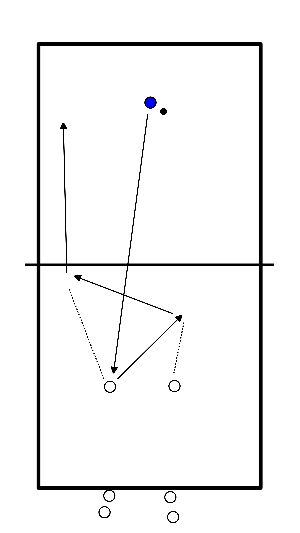
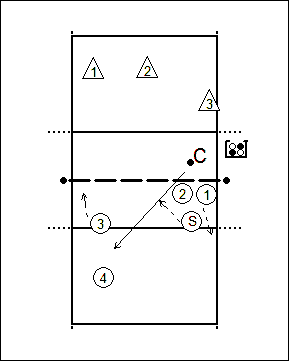
C attacks diagonally on 3 and 4- 1 and 2 after the block attack
3 and 4 defend, playmaker comes in
set-up to 1,2 or 3, attack to 3 defenders.
These defend for themselves and put the ball in the box.
- C throws a ball to A or B
- Set up a block on that side
- Pass the ball over the block to the defence
- Build up an attack on the middle
- Change after 10 balls
- Variation: attacking outside or behind
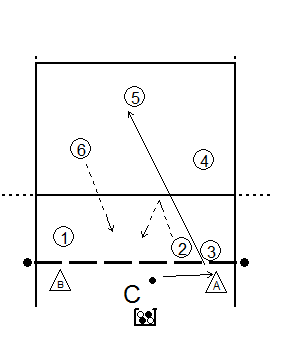
- 3 x 3.
- a trio at the net
- a trio in the backfield
- a threesome other side of the net
- - 1. exercise to improve block: three at this side of the net throws the ball to SV, who plays the ball to the trainer in front left 4.
- Trainer smashes ball against block
- other side of the net must take care of the good running line.
- Defender must connect left or right.
- Left players must block together, right players must take the ball.
- The 3 in the backfield also take care of the good running line.
- Libero covers the block.
- After 3 repetitions the group changes, after 9 repetitions the whole group changes.
- Split the group into pairs.
- The pairs will work through a number of stations, where different tasks have to be performed.
- Station 1: A slalom through several poles, with an underhand pass at the end of the slalom.
- Move as fast as possible between the poles.
- Station 2: One player lies down on the backline, while the other stands at the net with the ball.
- Player at the net hits the ball.
- Player in the backfield then stands up, and defends a hit ball at 7 meters, or a prik ball at the 3 meter.
- Station 3: Player stands in front of a trampoline, behind player 1 stands a second player with 2 tennis balls.
- One tennis ball is thrown into the trampoline, player 1 catches it before it hits the ground.
- The second tennisball is thrown quickly after it.
- Station 4: Simple, good block jumps, paying attention to the technique.
- Station 5: Reflex training: player stands with arms outstretched, a ball in each hand.
- Player 2 faces the other player, and reacts to the release of one of the balls.
- Do not make the distance between players too great to begin with.
- Each station has a working time of 1 minute.
- The ball is passed in the middle, after playing it, the player blocks it 2x, after that around the pylon play again
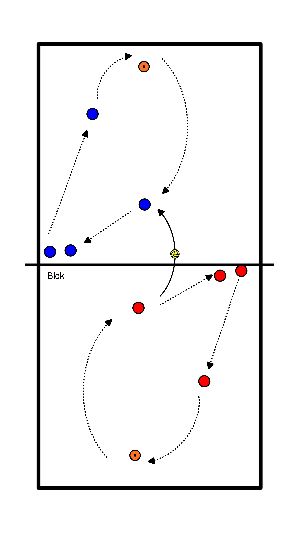
- On one side you attack with three attackers, on the other side you defend.
- Trainer throws balls for the playmaker
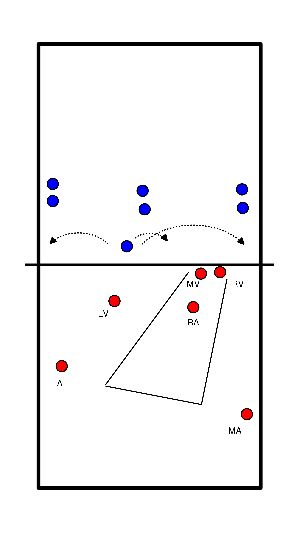
- Cabinet part at good height.
- Push off with 2 feet and jump to the back of the box.
- Variation: after jumping backwards, to pass the attack ball.
- Variation: after jumping from the box, block on smash, backwards to pass the attacking ball.
- Pairs stand on 2 and 3.
- First a block single (pay attention, after block jump down and back, for defense), then calmly back to the net, then second jump together on 2, so 3 connects.
- Then connect under the net, group.
- Other side the same, only trainer smashed against the block at second jump.
Blockboard at position 4 - street (two squares next to the antenna) - cone on 3 meter line
- Lene at position 3
- Receptionist at position 5 and attacker at position 4
- Attacker joins reception
Trainer passes ball to reception player
- Reception to setter
- Walk around cone
- Solve ball to play over net
Bad reception = compulsory play in block board
- Position 5 takes cover
- Play ball back to setter
- Pass and attack
- 6 players on one side of the net.
- 1 playmaker on the other side at right back
- 3 strikers +Tim as passer
- Joël throws in balls to Tim.
- Tim passes the ball to the playmaker, who chooses which attacker to pass to. The attacker can choose whether to hit or to place a passed ball behind the block.
starting position by showing chalk drawings on the ground for defending.
Warming up / all-round training
Each player will pass, attack, distribute, block, defend, rally, with turnovers.
#2 means
- Trainer stands with cart with balls at the pole at #2 (position 2)
- Players stand outside the field at the side of #1 and a playmaker at # 2/3
- First round starts with Trainer throwing the ball to #5, player 1 runs from the sideline to the ball and plays it to the distributor.
- Start with "blue players" (see drawing), then extend with "red players
Further course of play:
- Tr throws ball for S1 to #5
- S1 runs in and plays to Sv (#2/3)
- Sv gives setup to the outside (#4)
- S1 attacks.
- Turn over: S1 becomes Sv, Sv gets the ball and joins the line at #1.
Expansion 1
- Sv turns to the other side of the net and becomes a blocker.
Now the same steps as above, but with the block opposite the attacker. - Turn over: S1 (has just attacked) becomes Sv at #2/3, Sv
passes under the net and becomes B1 at #2B1
who, after blocking, goes to get the ball and joins the row
.
Extend 2
- After blocking at #2, player goes to defend at #5. Attacker is obliged to pass to #5.
- When the ball is defended a rally may be played (2 vs. 2)
- After end of rally or no defence or fault in attack, turn over
Extend 3 and more
- One can extend with a 2nd blocker, 2nd and 3rd defender (on resp. #1 and #6)
- More players can be added to field I (so players from the sideline move in when a rally arises)
- The passing game becomes S1 (passing and attacking) -> Sv -> B1 (#3) -> B2 (#2) -> V1 (#1) -> V2 (#6) -> V3 (#5) possibly A2 (#4) and then connect again.
- You can expand to 6 against 6, so start with blue, then B1, then B2, then V1, then V2 (when continuing the game, first V2 and then V1), then V3 (continuing the game with V2, V3, V1) and then possibly A1. In the meantime, players in field I must be added.
- If there are several players in Area I, you can choose to throw in a ball on S1 at #5 instead of throwing in a ball through Tr.
